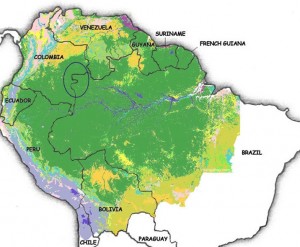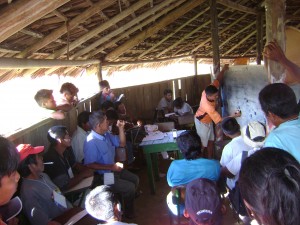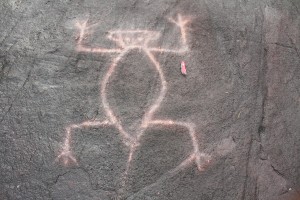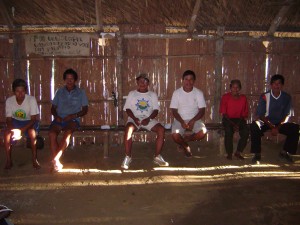9. Finding the right place for languages in the community landscape: language conservation in interdisciplinary projects among the Kubeos in the Northwest Amazon
This post is also available in: Catalan
Thiago Chacon
University of Brasilia
It is past 5pm in the house of Ricardo, a 60 year old Yúriwakɨ man, living in Açaí – a village of the Kubeo Indians at the Vaupés river in the Brazilian Northwestern Amazon. Roque, an older Yúriakɨ, is telling Ricardo and me about how the ancestral group of all humankind came into existence in the rapids of hipana in the Aiyari river, “the center of the world”. After the demiurge Yúri pushed humanity out from a hole in the rapids, he blew them with the sacred tobacco and each human group was set off into a journey in search for land, ceremonial power and spiritual nourishment (opeko ‘breast milk’). The journey is a process of transformation from a pre-human state in the aquatic world (moawɨ “fish-people”) to true people in the terrestrial world (põewã “humans”). For the Yúriwawa and brothers-in-law, the Yuremawa, the final point in their journey was Wakaipani, the rapids from a small tributary of the river, the unique ancestral birth-place of both groups.
Roque has never been to the Aiyari river; he has never seen most of the places of the journey he was describing. His voice, however, is firm, his memory is vivid and his words are galloping in a characteristic rhythm as he talks about places, events and make connections between mythical happenings and present affairs. As he speaks, Kubeo grammar makes it clear to the audience that Roque’s knowledge comes from retellings by his ancestors and from his own mind-travels to the places holding particular mythological significance.
Seven years have passed since I first heard the Kubeo creational myth. I was just starting my PhD, eager to document, learn and preserve the Kubeo language. As a linguist, who enjoys everything the linguistic code can teach about the Kubeos and their language, I started to think that language conservation should be more of a secondary objective, and that the emphasis should instead be on themes transversal to a number of aspects of community life. Since languages are “incidentally” also transversal to culture and society, it makes sense – at least in sociolinguistic situations like those of Kubeos – that language conservation should focus strategically on promoting community-based experiences of language use.
In our case, the Kubeos chose general traditional culture, sacred landscapes, territory and the environment as transversal themes. This text describes our initiatives related to these topics and considers the broader issues related to language and indigenous groups.[1]
Sociolinguistic situation of the Kubeos
The Vaupés is a unique multilingual region of the world, predating the arrival of Europeans in the Americas. Speakers of about twenty-two languages from four different linguistic families co-exist in a complex network of sociocultural exchange, embedded within a system of social and linguistic exogamy. In the twentieth century, and increasingly in the past decades, however, there have been dramatic changes that made an impact in language vitality. The most notable changes have been related to the presence of Christian missionaries, national armies, guerrilla wars, intense urban migrations, schooling, television, monetization, and diminishing supplies of fishing and game.
There are about eight thousand people who speak the Kubeo language; they are agriculturalists and rely heavily on fishing, as well as hunting and seasonal gathering of wild crops. Villages typically have about ten families (bigger ones can go up to one hundred families) and are dispersed along the banks of the Vaupés, Querari and Cuduyari rivers. In these villages, one usually hears, in addition to Kubeo, Kotiria, Tukano, Desano, as well Portuguese and Spanish. Most people are at least bilingual and others speak more than two languages. However, there has been a considerable break of language transmission to younger generations in certain areas of the Kubeo territory, not to mention the typical loss of specialized vocabulary and traditional linguistic performances. Nevertheless, although Kubeo can be regarded as a threatened language, its situation is not the most critical in the Vaupés, where smaller language groups are facing greater threats.
Landscapes and the right place of language for the Kubeos
My work with the Kubeos started with a series of workshops for an encyclopedic dictionary in 2008. Kubeo teachers from the local school requested that the dictionary should include translations from Kubeo to Kotiria, Tukano, Portuguese and Spanish. From the start, the connection of language and worldview, embodied in the native conception of an “encyclopedia”, has always guided the direction of our work. Workshops were thematically organized (natural world, human world and metaphysical world). They have proved very successful in engaging the entire community with an average attendance of 70 people from several distinct villages and ethnic groups. Besides the workshops, we also invested in the training of a group of young native speakers in the use of audio and video recordings, transcriptions and translations.
However, Kubeo community had many other needs in their daily life than “just” working with their language. While we could never tackle all the problems at once, there was a clear demand that future projects should bring more tangible components and resources. As a response, we came across with the idea of “sacred landscapes”, which then expanded into a project of territory and environmental management research.
Landscapes – as we realized after the research of anthropologists in the area, including Robin Wright, Geraldo Andrello, Ana Gita and my colleague Luís Cayón – are a central component for the understanding of how local indigenous groups relate myth, collective memory territory, the environment and the “mundane” present life. In fact, every piece of the landscape is a stronghold for Kubeo tradition and identity. One particular place is part of a complex network of mythical and mystical power, relating physical and metaphysical worlds, past events with current cultural practices. Shamans manage the substances that are utterly related to the evolution of the universe and humankind, bringing harm or well-being to the current world. Petroglyphs, topographical features and taboos to the “unprepared” persons are evidence of the active forces of certain places overtime. Means of subsistence too, such as fishing sites, hunting spots, agricultural areas, are all regulated by the power that flows from place to place. Several petroglyphs standing in different rocks along the rivers were made by the demiurges when the world was still in its genesis. Entire rivers and mountains were also the product of mythological events, such as the wanderings of the Sun in persecution of the Kubeo ancestors who have gotten the Sun’s daughter pregnant.
Language is, to a large extent, the key to every place. Comprehensive access to any place is only possible by knowing the true name of a place (not only some “nickname”), by the proper use of ceremonial dialogues with the mythical forces of that place and by knowledge of the correct position of a place within the chain of verses in a healing monologue or mythological narrative. Metaphor, metonyms and euphemisms abound in toponyms, which are also interrelated by a “grammar” of naming practices and hypertexts. It is only natural that the loss of language or particular linguistic skills by the younger generations could threaten not only a specific state of knowledge related to geography and territory, but also – and more profoundly – the entire conception of life and self for the Kubeos.
This kind of approach, where language is at the background of more tangible cultural practices and values, seems to be the right place for language programs among the Kubeos. In this framework, we are now experimenting a process that let us tackle several issues in Kubeo life, namely:
- intergenerational gap in cultural and linguistic transmission
- school curriculum, teacher training and integration between formal education and community education
- knowledge about fishing, gardening, hunting, income generation and sustainability
- discrepancies between traditional and modern life
- political and economic situations of the Kubeo community and the supra-local scenarios for indigenous peoples
- production of linguistic and cultural resources on toponyms, cartography, mythology and collective memory
Community-based research on Kubeo landscapes
In an evening of May 2013, a group of 30 people, comprised by schoolteachers and students, parents and other folks from the Kubeo communities in Brazil, arrived at Wakaipani, after a one-day trip through the jungle and the Marakarĩya river stream, a tributary of the Vaupés. The group arrived exhausted after wandering in the jungle in search for trails that have barely been used in the past decades. Those trails used to be the very source of game two generations ago, when the Kubeo Yúriwawa were still living in longhouses at the tributaries of the Marakarĩya stream. The culmination of the project was the trip to Wakaipani, a rocky flat area of the size of a football pitch, with several petroglyphs representing mythological events. The clear waters cut the rock in half along a North-South axis. The place is guarded by ancestors who take the form of shaman-jaguars (jawi) and harpy eagles (mi yawi ‘jaguar bird’).
As their graduation project, students from the last years of high school and mid-school had to do a research about the origins of the Kubeo clans Yúriwawa, Yuremawa and Betowa. They participated in a weeklong workshop with the elders, who narrated and chatted about events that occurred at Wakaipani just after the clans have emerged from the mythical aquatic journey. Students also received training in audio, video and photographic documentation, as well as in techniques of interviewing, ethnographic annotations and transcription.
Students were able to “feel” the Wakaini place to the fullest. They cleaned the lichens and grass from all petroglyphs; prepared fish and game locally caught; heard the long story about how the Kotirias and the Kubeos met at Wakaipani, how the territory was passed from the Kotirias to the Kubeos, and how the Sun demiurge was finally defeated by the Kubeos. Cameras, voice recordings and notebooks in the hand of the students documented everything, which resulted in a “home-made” documentary film about their experience.
More important than concrete results, the Wakaipani project has proven as a fruitful process of learning and dissemination of ideas and practices by all participants. However it only happened once. Lack of funding and lack of initiative from school members for conducting similar graduation projects without direct participation of outside researchers prevented it from perpetuation. If such a project is disconnected from subsequent collective actions, it will become just good memories in the minds and hearts of those 30 people who were part of it, but nothing more lasting.
It did, however, spread valuable seeds. One of them is a new momentum in Kubeo schools, supported by recent educational policies more open to indigenous way of life, where traditional knowledge is being more explicitly demanded in the curriculum. Some interesting ideas being discussed include hiring elders as regular instructors in the schools, locally produced pedagogical materials, and making graduation projects similar to the one in Wakaipani as a regular activity in the school calendar.
Another important consequence of this project was a subsequent project on territory and environmental research, whose general goal is to create local knowledge of the territory and its sustainable use for the future. This ongoing project is funded by the Ministry of the Environment in Brazil, and is conducted by the Kotirias and the Kubeos, engaging fifteen villages and ten local researchers, plus an interdisciplinary research team composed by a linguist (me), a biologist (Igor Richwin) and three anthropologists (Pedro Rocha, Diego Rosa and João Pimenta da Veiga). The project expands the focus from sacred landscapes in order to cover knowledge and management of the space regarding economical and technical use of the territory, history and demographic information of the villages, traditional knowledge about the environment and ongoing transformations, as well as the mythological configuration of the landscape. It also raises several issues about the current life in each village and the region as a whole, demanding collective discussions and further organization of local society.
The project lasted for 2 years and used a varied methodology, such as workshops, community discussions, mental maps and GIS, census, a log about local daily practices completed by local researchers, and documentation of traditional texts. As a result, we are currently writing a trilingual book (in Portuguese, Kotiria and Kubeo) that will cover chapters including geographical and environmental units, local cartography, sacred landscapes, demographic and sociolinguistic diagnosis of the communities, etc.
A conclusion of an ongoing work
After eight years working with the Kubeos, we feel that this is the moment to start something that could render more lasting results. Probably this will be true in ten years from now. Life never stops and the struggle of indigenous people is getting tougher every day.
Several challenges lie ahead of us. The most important from a language conservational perspective is keep the use of the Kubeo language vibrant in every way, in the digital world, in small talks and jokes, in rituals and in profanity, in writing and speaking, in thinking about the world and dialoguing with all kinds of social groups the Kubeo are open to.
Grants and thematic projects are still the best strategy for raising language awareness and reinforcing language use in threatened domains. A sociolinguistic survey followed by language planning is likely one of the next projects we will develop. In the meantime, I will go back to listening to Roque’s story about the creation of humankind by the Yúri god, the story that this note opened:
– ‘Hipanaka põewamu maha arehame. Mahãrẽ mahẽ ñekũ Yúri batekemawɨ̃ arehame’.
“We are from the Hipana rapids”, “For us, Yúri is our grandfather”, grampa said.
– ‘Yúri buçibɨre kɨwatekemawɨ̃ arehame. Buçibɨre kɨwarĩ, mahãrẽ mahẽ põe eta kobede buçibɨre nurĩ hapukemawɨ̃’.
“Yúri had a certain cigar”, he said. “With his cigar, he was blowing smoke into the hole from where people were created (born)”.
[1] This is what I could learn working with the Kubeos and seems to be a valid conception for several other sociolinguistic situations. Besides the Kubeos, I would like to give the right credit the institutions which supported my research on language conservation: the University of Brasilia where my colleague Luís Cayón and I are running a comparative project on the languages and groups of the Northwest Amazon; the University of Utah and the University of Hawa’i, where I finished my PhD; the University of California in Santa Barbara where I was a post-doc fellow; and Unesco and Iphan (Instituto do Patrimônio Histórico e Artístico Nacional) where I worked as a consultant for language policy issues in Brazil.




